Moonshot: Kennedy, Armstrong, and the Race to Land on the Moon
Even the White House ushers were abuzz on the morning of October 10, 1963, because President John F. Kennedy was honoring the Mercury Seven — astronauts Lt. Scott Carpenter (USN), Capt. Leroy “Gordo” Cooper (USAF), Lt. Col. John Glenn (USMC), Capt. Virgil “Gus” Grissom (USAF), Lt. Cmdr. Walter “Wally” Schirra (USN), Lt. Alan Shepard (USN), and Capt. Donald “Deke” Slayton (USAF) — with the coveted Collier Trophy that afternoon in a Rose Garden affair.
The trophy had been established in 1911 to be presented annually for “the greatest achievement in aeronautics in America,” with a bent toward military aviation. At the Mercury ceremony were representatives from such Project Mercury aerospace contractors as McDonnell Aircraft Corporation (designers of the capsule) and Chrysler Corporation (which fabricated the Redstone rockets for the U.S. Army’s missile team in Huntsville, Alabama). Kennedy wanted to personally congratulate the “Magnificent Seven” astronauts, all household names, for their intrepid service to the country. And his remarks marked the end of the Mercury projects after six successful space missions.
At the formal ceremony, Kennedy, in a fun-loving, jaunty mood, full of gregariousness and humor, presented the flyboy legends with the prize. Kennedy used the opportunity to drive home his brazen pledge of 1961, that the United States would place an astronaut on the moon by the decade’s end. Scoffing at critics of Project Apollo (NASA’s moonshot program) as being as thickheaded as those fools who laughed at the Wright brothers in 1903 before the Kitty Hawk flights, he turned visionary. “Some of us may dimly perceive where we are going and may not feel this is of the greatest prestige to us,” Kennedy said. “I am confident that its significance, its uses and benefits will become as obvious as the Sputnik satellite is to us, as the airplane is to us. I hope this award, which in effect closes out the particular phase of the program, will be a stimulus to them and to the other astronauts who will carry our flag to the moon and, perhaps someday, beyond.”
Even though Kennedy wasn’t alive for the fulfillment of his May 25, 1961, pledge to a joint session of Congress to land a “man on the moon” and return him safely to Earth, the marvel of television made it possible for more than a half-billion people to watch the historic Apollo 11 mission in real time, and I was one of them. On July 20, 1969, when Neil Armstrong gingerly descended from the spider-like lunar module the Eagle with his hefty backpack and bulky space suit, becoming the first human on the moon, I cheered like a banshee.
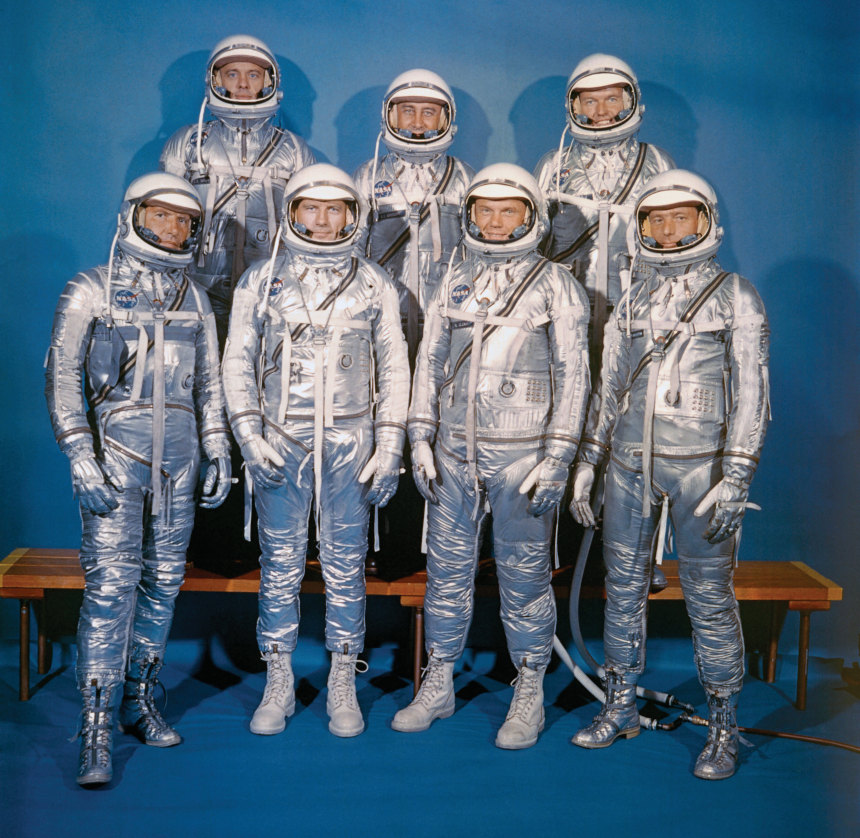
For years I longed to hear Neil Armstrong describe what it was like to contemplate Earth from 238,900 miles away, to explain, in his own words, the thermodynamics affecting motion through the atmosphere both in launching and reentry. Former Johnson Space Center director George Abbey of Houston (now a colleague of mine at Rice University) once told me that many NASA astronauts felt that looking at Earth was akin to a religious experience. Did Armstrong agree? What did it feel like, emotionally, spiritually, to stand on the surface of the moon? Armstrong’s reticence was legendary. He was known to be media shy.
It wasn’t until eight years later that NASA afforded me the privilege of interviewing Neil Armstrong for its official Oral History Project. I was surprised at and honored by the chance to speak in depth with the “First Man” — and thrilled when the date was set for September 19, 2001, in Clear Lake City, Texas. Then, eight days in advance of the big meeting, I saw the horrifying collapse of the World Trade Center towers on TV and listened to accounts of the two other disastrous airplane hijackings. A pervasive sense of gloom and urgency enveloped America. Like everyone else, I felt shock and repugnance at the ghastly scenes of our nation under attack, feelings that still burn to this day.
I was sure my Armstrong interview would be canceled. But it didn’t play out that way. To my utter astonishment, a NASA director telephoned me to say that Armstrong, no matter what, never missed a scheduled appointment. His effort to keep his word was legendary. The post-9/11 skies were largely shut to commercial aircraft, but Armstrong, whose own boyhood hero was flier Charles Lindbergh, refused to cancel his appointment at the Johnson Space Center, piloting his own plane from his adopted hometown of Cincinnati. It was a matter of honor, part of Armstrong’s “onward code.”
“I believe that this nation should commit itself to achieving the goal, before this decade is out, of landing a man on the moon and returning him safely to Earth.”
—John F. Kennedy, 1961
The six-hour interview went well. When I asked Armstrong why the American people seemed to be less NASA crazed in the 21st century than back during John F. Kennedy’s White House years, he had a thoughtful response. “Oh, I think it’s predominantly the responsibility of the human character,” he said. “We don’t have a very long attention span, and needs and pressures vary from day to day, and we have a difficult time remembering a few months ago, or we have a difficult time looking very far into the future. We’re very ‘now’ oriented. I’m not surprised by that. I think we’ll always be in space, but it will take us longer to do the new things than the advocates would like, and in some cases, it will take external factors or forces which we can’t control.”
Moments later, I again tried to get Armstrong to loosen up and be more expressive about his lunar accomplishment, to defuse his engineer’s penchant for personal detachment. I had long pictured him in the sultry evenings at Cape Canaveral leading up to the Apollo 11 launch, looking up at the luminous moon and knowing that he and Edwin “Buzz” Aldrin would soon be the first humans to visit a place beyond Earth. “As the clock was ticking for takeoff, would you every night or most nights, just go out and quietly look at the moon? I mean, did it become something like ‘My goodness?!’” I asked. “No,” he replied. “I never did that.” That was the extent of his romantic notions about the lifeless moon. Neil Armstrong was first and foremost a Navy aviator and aerospace engineer, following military orders with his personal best.
What became clear to me after interviewing him (and other Mercury, Gemini, and Apollo astronauts of 1960s fame) was that the story of the American lunar landing wasn’t wrapped up in any idealized aspiration to walk on the moon surface; instead, it was all about the old-fashioned patriotic determination to fulfill the pledge made by President Kennedy on the afternoon of May 25, 1961. “I believe,” our 35th president had said before Congress, “that this nation should commit itself to achieving the goal, before the decade is out, of landing a man on the moon and returning him safely to Earth.”
Only one top-tier Cold War politician had the audacity to risk America’s budget and international prestige on such a wild-eyed feat within such a short time frame: In John F. Kennedy, the man and the hour had met. Without Kennedy’s daunting vow to send astronauts to the moon and bring them back alive in the 1960s, Apollo 11 would never have happened in my childhood. It’s my contention that if JFK had been wired differently — if he hadn’t had such a hard-driving father who raised him with the need to achieve great things, or a brother who died in World War II trying to destroy a German missile facility — then the moonshot might not have happened.
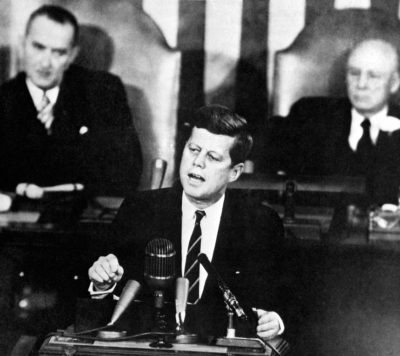
For Kennedy, who himself became a World War II naval hero for his bravery in the PT-109 incident of 1943 in the Pacific Theater, the Project Mercury astronauts were ultimately fearless public servants like him. The NASA astronauts Kennedy had feted in the Collier Trophy ceremony weeks before his assassination volunteered for space travel duty at a pivotal moment in the Cold War. Like Kennedy, these astronauts were courageous, pragmatic, and cool; they were husbands and fathers who, as journalist James Reston noted, “talked of the heavens the way old explorers talked of the unknown sea.” Kennedy’s New Frontier ethos was based on adventure, curiosity, big technology, cutting-edge science, global prestige, American exceptionalism, and historian Frederick Jackson Turner’s famous “frontier thesis.” All six of NASA’s Mercury missions occurred during Kennedy’s presidency. With Madison Avenue instinct, Kennedy routinely claimed that space was the “New Ocean” or “New Sea.” If so, then he was the navigator in chief ordering NASA spacecraft with noble names such as Freedom, Liberty Bell, Friendship, Aurora, Sigma, and Faith into the great star-filled unknown. His talent for converting Cold War frustration over Soviet rocketry success into a no-holds-barred competition for the moon was politically masterful. And the American public loved him for leading the effort.
It’s fair to argue that NASA’s Projects Mercury, Gemini, and Apollo were just a shiny distraction, that the taxpayers’ revenue should’ve been spent fighting poverty and improving public education. But it’s disingenuous to argue that Kennedy’s moonshot was a waste of money. The technology that America reaped from the federal investment in space hardware (satellite reconnaissance, biomedical equipment, lightweight materials, water-purification systems, improved computing systems, and a global search-and-rescue system) has earned its worth multiple times over. Ever since, whenever we have worried about an America in decline, Kennedy’s moonshot challenge has stood as the green light reminding us that together as a society we can accomplish virtually any feat.
Full of blithe optimism, Kennedy’s pledge set an audacious goal, capping a three-and-a-half-year period in which the Soviet Union twice shocked the world, first by launching the first orbital satellite, on October 4, 1957, and then by sending cosmonaut Yuri Gagarin on the first manned space mission on April 12, 1961, just six weeks before Kennedy’s rally cry to Congress. For a world locked in a Cold War rivalry between the Americans and the Soviets, space quickly became the new arena of battle. “Both the Soviet Union and the United States believed that technological leadership was the key to demonstrating ideological superiority,” Neil Armstrong explained later. “Each invested enormous resources in ever more spectacular space achievements. Each would enjoy memorable successes. Each would suffer tragic failures. It was a competition unmatched outside the state of war.” Kennedy, with depth and commitment, articulated a visionary strategy to leapfrog America’s communist rival and win that high-stakes contest in the name of the capitalistic free-market system as represented by the United States. It was just a matter of figuring out how to do it, using engineering exactitude, military know-how, taxpayer dollars, and political pragmatism.
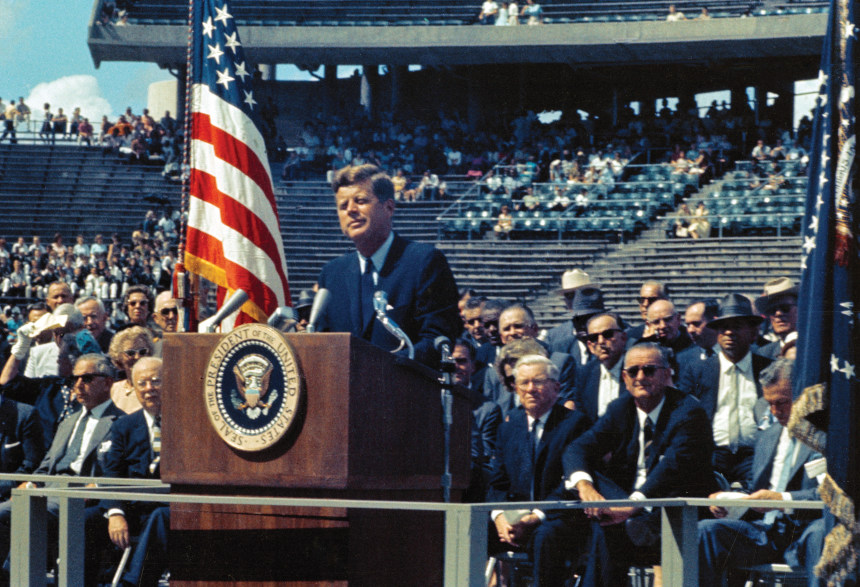
Calculating that the American spirit needed a boost after Sputnik, Kennedy decided that beating the Soviets to the moon was the best way to invigorate the nation and notch a win in the Cold War. But he also understood that a vibrant NASA manned space program would involve nearly every field of scientific research and technological innovation. U.S. leadership in space required specialists who could innovate tiny transistors, devise resilient materials, produce antennae that would transmit and receive over vast distances never before imagined, decipher data about Earth’s magnetic field, and analyze the extent of ionization in the upper atmosphere. President Kennedy bet that a lavish financial investment in space, funded by American taxpayers, would pay off by uniting government, industry, and academia in a grand project to accelerate the pace of technological innovation. He doubled down on Apollo even while calling for tax cuts. Breaking up congressional logjams over NASA appropriations became a regular feature of his presidency.
Though the cost of Project Apollo eventually exceeded $25 billion, the intense federal concentration on space exploration also teed up the technology-based economy the United States enjoys today, spurring the development of next-generation computer innovations, virtual reality technology, advanced satellite television, game-changing industrial and medical imaging, kidney dialysis, enhanced meteorological forecasting apparatuses, cordless power tools, bar coding, and other modern marvels. Shortsighted politicians may have carped about the cost, but in the immediate term, NASA funds went right back into the economy: to manned space research hubs such as Houston, Cambridge, Huntsville, Cape Canaveral, Pasadena, St. Louis, the Mississippi-Louisiana border, and Hampton, Virginia, to the thousands of companies and more than 400,000 citizens who contributed to the Apollo effort.
“We choose to go to the moon in this decade and do the other things, not because they are easy, but because they are hard.”
—John F. Kennedy, 1962.
Even without the manifest technological and societal benefits of Apollo, Kennedy would have set a course to the moon because he believed America had an obligation to lead the world in public discovery. For though the moon seemed distant, in reality, it was only three days away from Earth. On September 12, 1962, at the Rice University football stadium, Kennedy offered the nation a stirring rationale for Apollo. Identifying the moon as the ultimate Cold War trophy and throwing his weight behind landing there was the most daring thing Kennedy ever did in politics. “Why, some say, the moon? Why choose this as our goal? And they may well ask, why climb the highest mountain? Why, 35 years ago, fly the Atlantic? … We choose to go to the moon in this decade and do the other things, not because they are easy, but because they are hard, because that goal will serve to organize and measure the best of our energies and skills, because that challenge is one that we are willing to accept, one we are unwilling to postpone, and one which we intend to win.”
During Kennedy’s Rice speech, he deemed space the ocean ready to be explored by modern galactic navigators. “We set sail on this new sea,” he said, “because there is new knowledge to be gained, and new rights to be won, and they must be won and used for the progress of all people.” By the time Kennedy stepped down from the Rice dais, his memorable words had been seared into the imaginations of every rocket engineer, technician, data analyst, and astronaut at NASA. It was that rare moment when a president outperformed expectations. “The eyes of the world now look into space,” he had vowed, “to the moon and to the planets beyond, and we have vowed that we shall not see it governed by a hostile flag of conquest, but by a banner of freedom and peace. We have vowed that we shall not see space filled with weapons of mass destruction, but with instruments of knowledge and understanding. Yet the vows of this nation can only be fulfilled if we in this nation are first, and, therefore, we intend to be first. In short, our leadership in science and in industry, our hopes for peace and security, our obligations to ourselves as well as others, all require us to make this effort, to solve these mysteries, to solve them for the good of all men, and to become the world’s leading space-faring nation.”
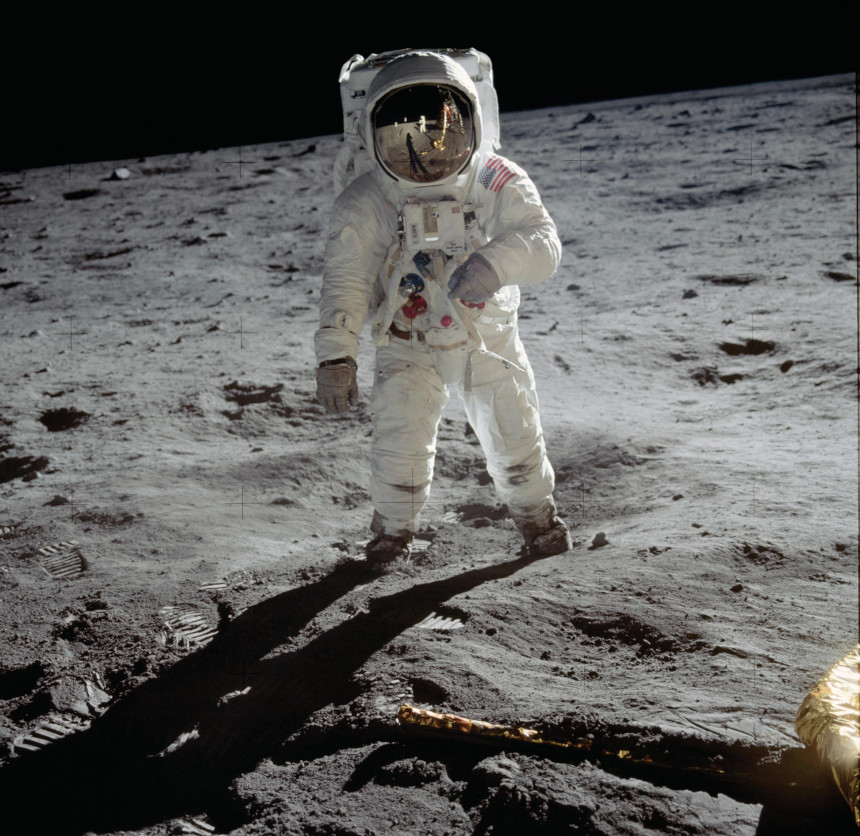
Throughout the United States there is a hunger today for another “moonshot,” some shared national endeavor that will transcend partisan politics. If Kennedy put men on the moon, why can’t we eradicate cancer, or feed the hungry, or wipe out poverty, or halt climate change? The answer is that it takes a rare combination of leadership, luck, timing, and public will to pull off something as sensational as Kennedy’s Apollo moonshot. Today there is no rousing historical context akin to the Cold War to light a fire on a bipartisan public works endeavor. Only if a future U.S. president, working closely with Congress, is able to marshal the federal government, private sector, scientific community, and academia to work in unison on a grand effort can it be done. NASA has achieved other astounding successes in the realm of space, such as exploring the solar system and cosmos with robotic craft and establishing a space station, but without presidential drive, these didn’t galvanize the national spirit. Kennedy’s moonshot was less about American exceptionalism, in the end, than about the forward march of human progress. For as the Apollo 11 plaque left on the moon by Armstrong and Aldrin reads, WE CAME IN PEACE FOR ALL MANKIND.
This article is featured in the July/August 2019 issue of The Saturday Evening Post. Subscribe to the magazine for more art, inspiring stories, fiction, humor, and features from our archives.
Featured image: NASA
How America Almost Lost the Space Race
In 1962, a top scientist at NASA declared that landing a man on the moon would be “the most dramatic physical event in history.”
His assessment was shared by many, including President Kennedy. So it was no surprise that America poured millions into its space program. And no surprise that getting to the moon became a contest between the U.S. and its ideological rival: the U.S.S.R.
The Cold War was heading to outer space.
The American space program had Wernher von Braun, the former Nazi officer who had developed the V-2 rocket that terrorized London in World War II. By capturing him and putting him to work on their own rocket program, the United States’ space program took a giant step forward.
However, the Russians had Sergei Korolev. As early as 1933, he was launching rockets for the Soviets. But the Russian program fell behind in 1938, when Korolev was sentenced to a Gulag on charges of being “anti-Soviet.” After six years, he was released and sent to work with the German rocket scientists being rounded up by the Red Army. Three years later, he successfully launched the R-2, Russia’s version of the V-2 rocket.
Meanwhile, the Americans, under von Braun’s direction, were launching V-2 replicas in the New Mexico desert.
The Russians began pulling ahead. Under Korolev’s direction, they started developing multi-stage payloads to give their rockets more power and versatility. By 1949, they had extended the range of their rockets to 186 miles. By 1957, their missiles could fly over 4,000 miles and deliver a payload — like a nuclear bomb — weighing up to five tons. They could also — in theory — send men into orbit around the earth.
Then, on October 4, 1957, came the announcement that shocked America. The Soviets had launched a missile with a thrust over six times greater than any U.S. missile and sent a satellite into orbit around the world — The Sputnik I.
In an editorial from its November 9, 1957, issue, The Saturday Evening Post declared, “Nobody but an idiot would declare that Russia’s Sputnik is just a stunt without military significance. Plainly the Soviet Union’s success in launching this satellite carries enormously important implications, among them the possibility that the Reds will be able presently to unload devastating missiles upon this country.”
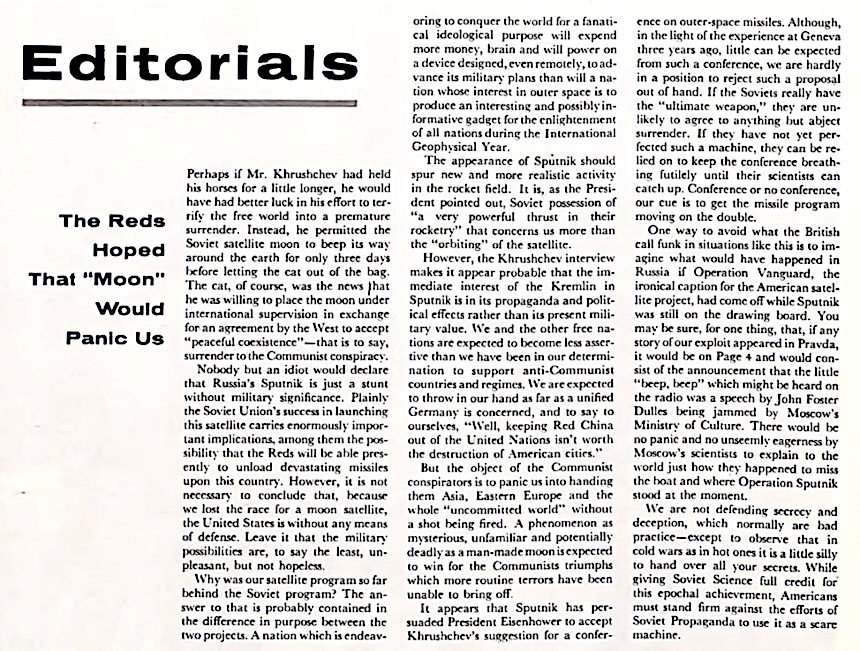
Officials in Washington had been closely monitoring the Soviet space program. They realized that the Russians now had the capability to launched a nuclear warhead onto American soil. Just as important, the success of the Sputnik launch had diminished American technology and expertise in the eyes of the world.
Sputnik put new urgency in the U.S. space program. Unfortunately, American prestige suffered a further setback in December 6, 1957, when the launch of a U.S. Vanguard rocket, televised live to the nation, failed spectacularly.
The failed Vanguard rocket launch on December 6, 1957 (Uploaded to YouTube by NASA Langley CRGIS)
In 1959, Russia launched the first space probe to reach the moon. And in 1961, they put the first man in space when cosmonaut Yuri Gagarin orbited the earth.
So it isn’t surprising to see a Post author in 1962 asking “Can We Still Be the First on the Moon?” The answer, according to author Don A. Schanche was not “particularly reassuring.”
The Soviet rockets were, he wrote, considerably more powerful. They were developed with the goal of doing the heavy lifting to carry nuclear bombs to the U.S. Meanwhile American scientists focused on launching lightweight satellites. Rather than developing more powerful rocket engines, the U.S. team spent their time on miniaturizing its space equipment.
Now NASA turned its attention to developing more powerful booster engines, like the Titan and Saturn series. But this still wouldn’t let the Americans catch up, Schanche wrote. Russians were within a month of being able to link up two space vehicles, something America wouldn’t achieve until 1966.
What Schanche couldn’t have foreseen was that the U.S. space program would build up momentum by 1965. In the following two years, it accomplished its first spacewalk, first spacecraft orbit change, an eight-day spaceflight, a 14-day spaceflight, and the first spacecraft docking.
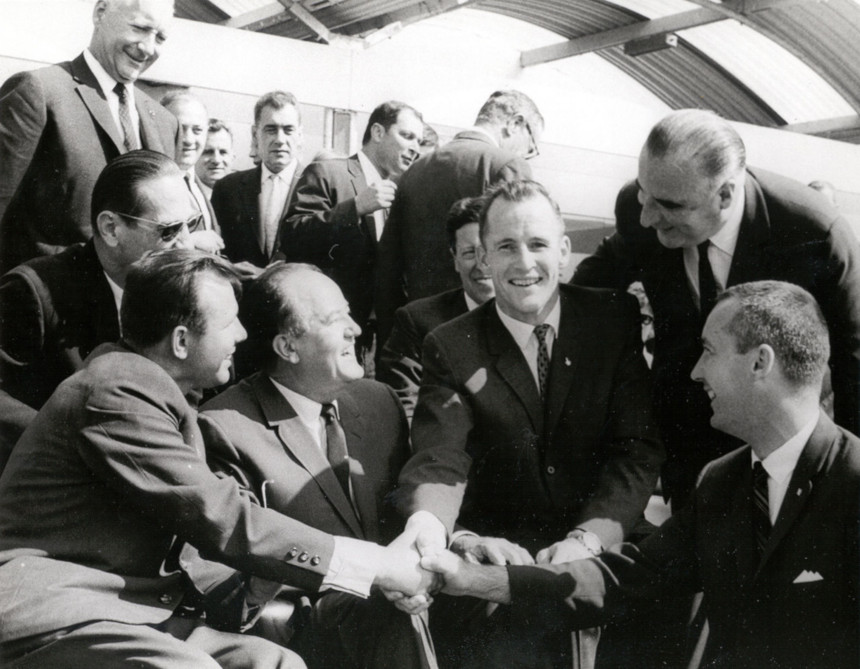
And that linkup between two Russian space craft expected in 1962? It didn’t occur for another five years.
The two countries’ space programs underwent a reversal of fortune in 1966, when Sergei Korolev died suddenly. There was no competent successor. The next Soviet manned rocket, launched the next year, resulted in the first cosmonaut’s death in Russia’s space program. Russia’s moon landing, planned to celebrate the 50th anniversary of the Bolshevik Revolution, never took place.
With the Apollo 11 mission safely returning from the moon, the Americans declared the space race over and won. Seeing America’s advances, the Soviet program switched its efforts to building space stations.
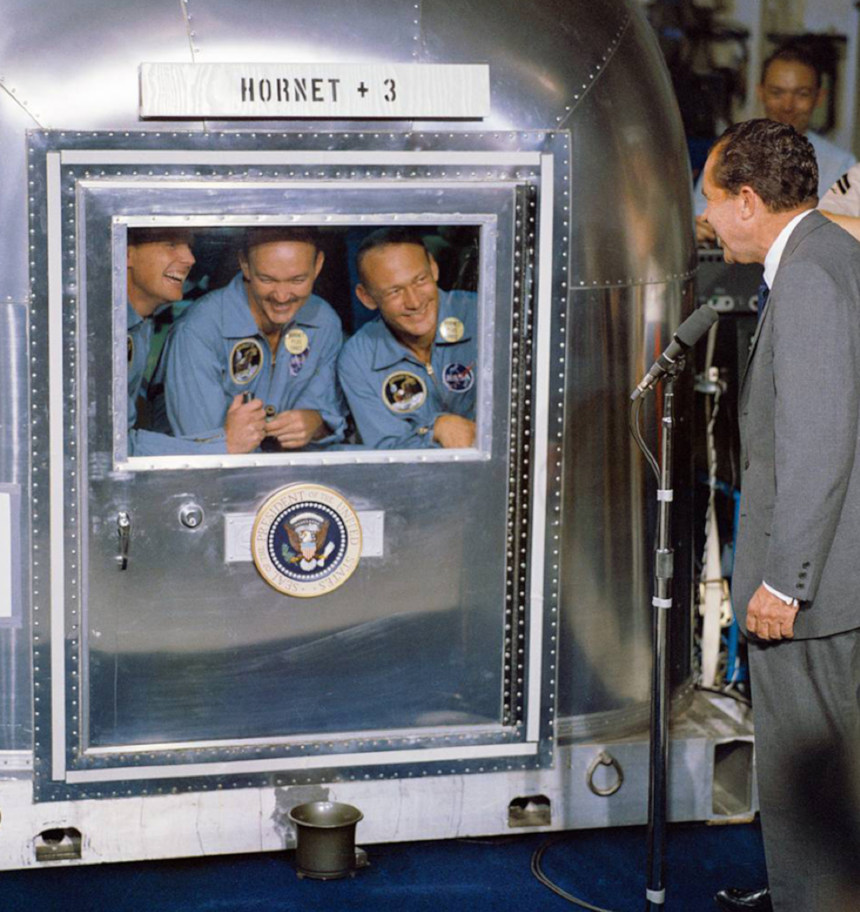
The contest over, at least to American satisfaction, the way was clear for cooperation instead of competition. Six years after the moon landing, in 1975, America linked up its Apollo space craft with the Russian Soyuz space station 18 for the first international space mission.
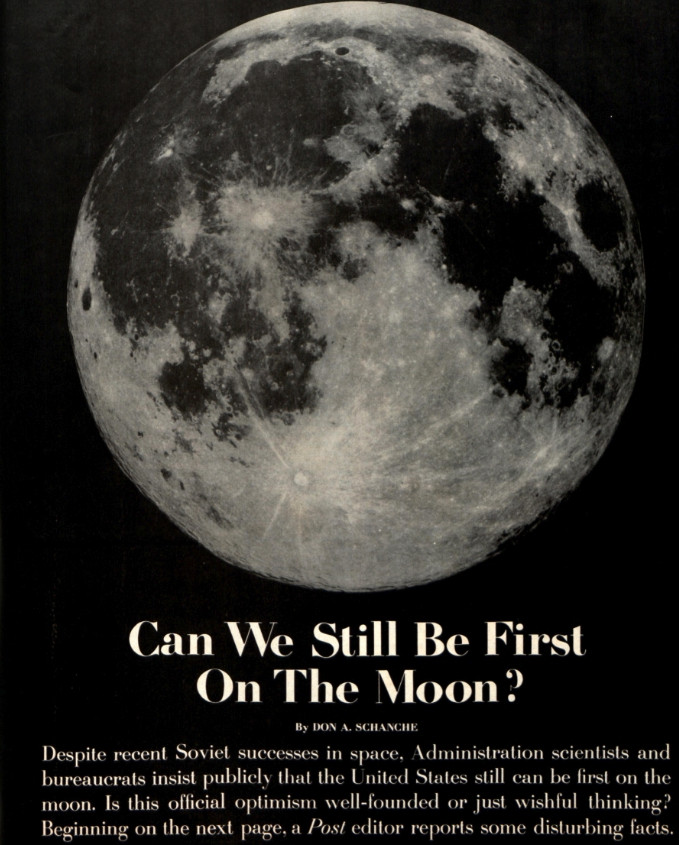
Featured image: Apollo 11 mission control celebrates. (NASA)
The Moon Rock Hunter Is Coming for You
If you happen to be in possession of a stolen piece of the moon, look over your shoulder.
Joe Gutheinz is after you.
Not that the moon misses those rocks — there’s plenty more where that came from — but Americans paid upwards of $25 billion to bring back just 842 pounds of soil and stones during six Apollo missions from 1969 through 1972, and it doesn’t look like we’ll be scooping up more any time soon.
Combine the exotic appeal of moon rocks with the limited supply of them, and you’ve got a commodity that’s a prime target for people looking to make a buck. “One guy was asking for $5 million for a few grams of moon rock,” says Gutheinz. “Five million! I wasn’t sure even a moon rock was worth that much money, so I checked around on the black market.
“Turns out, $5 million is just about right.”
They’re the ultimate hot rocks.
Following Apollo 11, America’s first lunar mission, the U.S. presented a few tiny moon rocks, embedded in Lucite balls, to every U.S. state and territory — and 135 more to every nation of the world. Each was mounted on a plaque bearing the name and flag of the state or country to which it was presented. You’d think all the lucky recipients would have taken good care of those infinitely rare specimens. And you’d be wrong.
For more than 20 years, Gutheinz has been known as the Moon Rock Hunter. He started out tracking down crooks selling fake lunar samples, but very soon found himself hot on the trail of actual stolen moon rocks and the shady characters who peddled them. Through hushed phone calls, clandestine meetings in distant cities, and expeditions to the darker corners of the internet, Gutheinz always got his man — and his moon rock.
One look at Gutheinz, with his square jaw and determined stare, and it’s clear he’s not a guy you want to mess with. For years, he was a top agent in NASA’s Office of Inspector General, tracking down and prosecuting contractors who bilked the agency. Whether it was a simple matter of overcharging NASA for services or a complex scheme where a guy rented warehouses from himself and then double-charged the agency, Gutheinz was legendary for following each receipt and canceled check to the last ill-gotten penny.
“That was fun,” Gutheinz says — but what he really liked was tracking down crooks who said they had moon rocks for sale.
You may be surprised to learn that people have been selling fake moon rocks almost from the moment Neil Armstrong, Buzz Aldrin, and Mike Collins returned from the first lunar mission in 1969.
“It was actually a pretty big thing,” says Gutheinz. “It really began in 1969, when a door-to-door salesman in Miami was selling bogus moon rocks that he claimed came from the Apollo 11 mission.”
Hard as it is to believe that even the most gullible mark would fall for a line like that, you need only look back through history to realize those poor saps in Miami were following a long, time-honored tradition: For centuries, con men have peddled bogus bits of history, ranging from splinters of the True Cross to strands from George Washington’s wig. In all likelihood, some Neanderthal guy went cave-to-cave selling fake mastodon teeth.
Luckily for Gutheinz, many of the would-be moon rock sellers were even dumber than their victims.
“Here’s an example,” says Gutheinz, and from the excitement in his voice you can instantly tell moon rock stories are his favorite kind. “In the 1990s, a guy named Ronald Trochelmann and his brother were trying to sell a moon rock at auction.
“Let’s just get the moon rocks back… so people can appreciate the fact that humans went to space and walked on another world.”
“The FBI got a tip-off on that one, because they were saying John Glenn gave it to their father after he returned from the moon.
“Of course, they didn’t study their history close enough and didn’t realize John Glenn never got to the moon!”
What makes a good fake moon rock? It’s not rocket science: “Mostly they’re rocks you pick up in your backyard,” Gutheinz says. “Then you jack it up with some sort of fake NASA letterhead indicating that Neil Armstrong gave it to you.
“The thing is, it’s a perfect scam. You tell your mark, ‘Look, I’ve got this moon rock from Neil Armstrong, and I’ll sell it to you for a measly 18 grand. But you can never tell anybody you’ve got a moon rock, because NASA says it’s a national treasure, and if you tell anybody about it, agents will kick down your door and grab it!’
“So nobody talked about having a moon rock, or they waited years to talk about it. And we were there waiting around to hear from victims who had good reason not to fess up.
“Finally, one day I said, ‘Gee, we’re doing this backwards. We need a sting operation.’”
In 1998, Gutheinz and his NASA team, along with the U.S. Postal Service and U.S. Customs, launched Operation Lunar Eclipse, a nationwide sting operation aimed at shutting down the fake moon rock trade. The quarter-page ad in the September 18, 1998, issue of USA Today was remarkably frank: A company called John’s Estate Sales was interested in buying moon rocks. If you have a moon rock you want to sell, call this number.
The home office of John’s Estate Sales was, in fact, a small room at the NASA Inspector General’s Houston office. In that room was a small desk, a tape recorder, and a telephone. Nothing else.
“It’s called a hello line,” says Gutheinz. “And there’s only one reason to answer it: Someone is calling to sell a moon rock.
“My undercover name was Tony Coriasso. If the phone rang, I’d walk across the office, pick up the phone, and say, ‘John’s Estate Sales, Tony Coriasso speaking,’ and we’d go from there.”
“From there” often entailed a delicate game of cat and mouse as Gutheinz played the skeptical dealer and the person on the other end of the line tried to figure out if this was some kind of trap. Of course, it wasn’t a fair fight: The sellers were amateurs and Gutheinz was a pro.
Operation Lunar Eclipse was a stellar success. One by one, furtive “moon rock” owners came forward only to face the double humiliation of being caught — and learning their treasured moon rock probably came from a backyard in North Jersey.
Business was good in the fake moon rock racket. But then one day, Gutheinz recalls, he got a call unlike any of the others. “This guy says, ‘Hi Tony, I saw your ad in USA Today. I wanna tell you something: All those people calling you? They’re calling you with bogus moon rocks.’”
Gutheinz nodded to himself. Yeah, he thought, tell me something I don’t know.
And then the guy did just that: “I’ve got the real thing.”
Of course, all the callers insisted they had “the real thing.” But there was something about this guy that sent a tingle up Gutheinz’s spine.
“Here’s the deal,” said the voice. “I’ve got a real moon rock, and if you go to this web page you’ll see it.”
Gutheinz wrote down the web address, pulled up the page — and couldn’t believe his eyes. There was a photo of a 10-by-14-inch plaque. Mounted on it was a Lucite ball — and embedded in the ball Gutheinz could clearly see a tiny pebble. On the face of the plaque was a plate depicting some national flag, but a piece of black tape obscured most of it, shielding the country’s identity.
“It’s an Apollo 17 moon rock,” the seller said — and at that moment Gutheinz realized the guy was probably telling the truth. Apollo 11’s moon rock plaques had a scattering of lunar pebbles embedded in their Lucite balls. After America’s final lunar mission, Apollo 17, more plaques were distributed, only this time each Lucite ball contained just a single small rock, like the one Gutheinz was looking at on his computer screen.
Posing as Tony, Gutheinz told the guy he was interested and set up a meeting in Miami. Gutheinz met the seller, a Miami businessman named Alan Rosen, in a restaurant. To Gutheinz’s dismay, Rosen didn’t bring the rock. He did, however, come with the story of how he got it. “He told me it was brought into the U.S. but not disclosed to Customs, which you’re supposed to do,” says Gutheinz.
“Meanwhile, I was working with the lunar curators at NASA, and I found out we did not keep any kind of records of where the recipient states, territories, and countries kept their moon rocks.”
From the mostly obscured national flag on the plaque, Gutheinz knew the rock was from one of six Central American countries.
“I checked with each of them, and it turned out not one of those countries knew where their moon rocks were. Not one! What’s more, Nicaragua allegedly had a moon rock that was sold in the Middle East for between 5 and 10 million dollars.”
Based on that market price, Gutheinz made Rosen a low-ball offer: $5 million. Rosen agreed, but before he turned over the rock, he wanted to see the money.
That was a problem. NASA doesn’t keep that kind of cash lying around, especially for the purpose of flashing it before the eyes of a smuggler. On the other hand, Gutheinz was in Texas, where more than a few super-rich patriotic Americans might be willing to help preserve a piece of U.S. history. For Gutheinz, the first such billionaire to try was obvious: He placed a call to the office of H. Ross Perot. And of course, the flamboyant billionaire and two-time U.S. presidential candidate jumped at the chance to be part of an out-of-this-world sting operation. “Perot was great,” says Gutheinz. “He put up the $5 million.” Perot designated the cash to an account at the Miami bank where Rosen said he had the rock stashed and instructed the bank’s vice president to produce a letter stating that the $5 million was to be used for the purchase of a moon rock. According to the elaborate plan, “Tony” got to select the bank officer who would take a picture of the rock at the Miami bank and send it electronically to him in Houston so he could confirm the rock was the real deal.
Still, Rosen was suspicious. On the day he was to reveal the rock in the Miami bank, he insisted that Gutheinz call him from Houston, to prove he wasn’t a federal agent waiting in the next room to spring a trap. When Rosen’s cellphone showed Gutheinz’s call coming from Houston, he was satisfied. “But he didn’t know how cellphones work,” says Gutheinz. “His phone showed I was calling from a Houston area code — but it didn’t show where I was actually at!”
He was, as Rosen had feared, right there at the Florida bank. And the “bank officer” was an undercover U.S. Customs agent. The moment Rosen produced the telltale Lucite ball, the agent confiscated it — and Gutheinz swooped in to make the arrest. “We looked in the trunk of his car, and there was the 10-by-14-inch plaque, without its Lucite ball. It had been given to Honduras.”
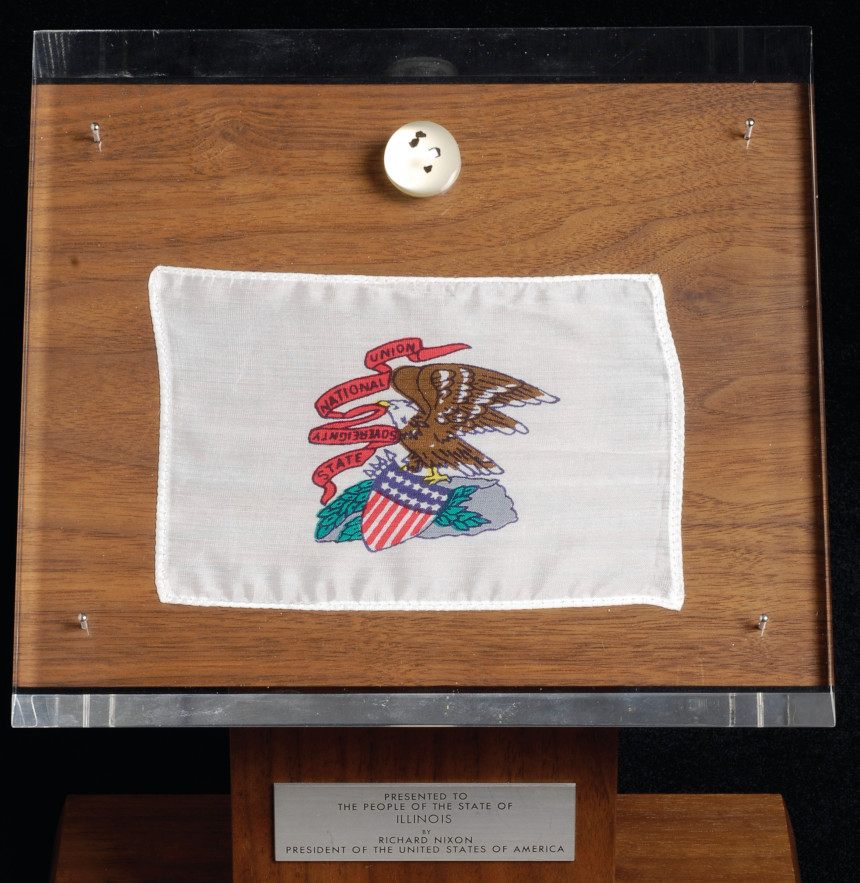
Besides tracking down moon rocks and nabbing crooked contractors, Gutheinz also headed up investigations into the dangers present in the Russian MIR spacecraft. He unmasked an astronaut impostor named Jerry Allen Whittredge who actually bluffed his way into Mission Control and walked off with schematic drawings for the space shuttle. But after his experience with Rosen, he began losing interest in hustlers selling fake moon rocks and found himself thinking more and more about how many of the real ones were missing — and was frustrated that NASA didn’t have the resources to launch a full-scale search. So when he retired from NASA in 2000 and began teaching classes at the University of Phoenix, he decided to give his criminal justice graduate students some unusual field experience: Tracking down those missing rocks.
“Over a 10-year period, our Moon Rock Project used about 1,000 students to find moon rocks,” he says. “They loved it. Besides the Honduran moon rock, with my students we found 78 more.”
There’s no telling how much skullduggery goes into the black market of moon rocks that were given to other countries, but within the U.S., it appears most of the missing rocks were simply carried out the door by state officials who thought they were entitled to them.
“Colorado Governor John Vanderhoof was a war hero, but he apparently didn’t understand that the moon rock was given to the state, not to him,” Gutheinz says. “So when he left office in 1975, he just grabbed the Apollo 17 plaque and took it home. It hung there for 25 years, until 2010.
“Then you have Arch Moore Jr., the governor of West Virginia. When he left office under a cloud, he took the state’s moon rock. He gave it to his law partner, and it ended up hanging in that guy’s garage.
“When Missouri Governor Kit Bond became a senator, he took the state’s moon rock with him to D.C.
“So there you have three governors who each walked out the door with a $5 million moon rock!”
Coleman Anderson was one of the original Alaskan boat captains in the cable series Deadliest Catch — but his most valuable catch was arguably Alaska’s Apollo 11 moon rocks. Anderson got the rocks from his foster father, who was curator of the state transportation museum in Juneau at the time the place burned down in 1973. The rocks were assumed lost in the fire, but that wasn’t the case.
“He found the plaque after the fire, saw it was in pretty good shape, and took it,” says Gutheinz.
In 2011, after word leaked out that he had the rocks, Anderson sued the state seeking permanent ownership, claiming they had been abandoned.
“Or else,” says Gutheinz, “he offered to return the rocks if the state paid him a monthly maintenance fee for all the years he had it.
“He lost that case. It wasn’t his rock.”
There’s no question that anyone who has an Apollo moon rock is probably in possession of stolen property, but Gutheinz isn’t interested in punishing the people caught with secret stashes. “We never accuse anyone of wrongdoing, of stealing the moon rocks,” he says. “Let’s just get the moon rocks back, put them in museums and planetariums and universities so people can appreciate the fact that humans went into space and walked on another world.”
These days, Gutheinz’s bread-and-butter business is his Friendswood, Texas, law firm, which specializes in criminal defense and family law. Two of his sons, fellow U.S. Army veterans, are partners. But he’s still hot on the trail of missing moon rocks as well as other lost pieces of America’s space program legacy.
“Right now I’m tracking down a Gemini space capsule,” he says. “Actually, it was probably a training capsule, but it would still be worth finding.
“A guy’s father had it, and he gave it to a city. Then the city lost control of it, and they have no idea where it is. Finding a capsule is a little different from finding a moon rock. It’s harder to hide. If I had to guess, it’s probably in plain sight, in some school playground.”
Meanwhile, Gutheinz is still hopeful he can make a dent in the list of still-missing U.S. state and territory moon rocks from Apollo 11 (Delaware, New York, U.S. Virgin Islands) and Apollo 17 (Louisiana, Michigan, New Jersey, Ohio, South Carolina, Puerto Rico). He’s less interested in tracking down the nearly 200 other moon rocks that are still at large around the globe. “When you give two moon rocks to the government of Moammar al-Gadhafi,” he says, “Don’t be surprised when they’re not there anymore.”
“Colorado Governor John Vanderhoof was a war hero, but apparently didn’t understand that the moon rock was given to the state, not to him.”
Other than the thrill of the chase, just what is it about finding moon rocks that is so compelling to Gutheinz? The answer might lie in a chat he had one day with a NASA astronaut.
“I asked him, ‘Are these things really worth $5 million?’
“He said, ‘Joe, I don’t have a clue what they’re worth. But let me tell you what they’re worth to me. When I was a kid, I always wanted to be a pilot. Then I went to a museum. I was walking in there, and there was this moon display — and this rock. As I got closer, it changed me. I’d always wanted to be a pilot — now I wanted to be an astronaut.’
“That really hit me. These dictators and kings who keep their country’s moon rocks for themselves, they’ve got the wrong idea. Moon rocks aren’t for the very wealthy. They’re for the very poor, to see a moon rock in a museum, and to have that kind of experience. It’s cool to think I can get just one moon rock back, and then some kid who can’t even afford to buy good shoes walks into a museum and sees that moon rock and says, ‘You know what? Do a little math, a little science, and who knows? Maybe I could go into space.’
“That I can understand. It’s a worthy goal.”
This article appears in our May/June 2019 issue. Subscribe to the magazine for more art, inspiring stories, fiction, humor, and features from our archives.
Featured image: NASA/Eugene Cernan